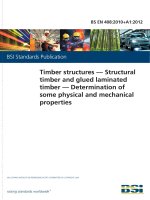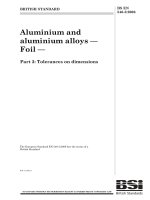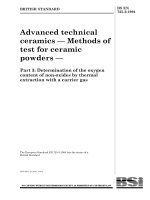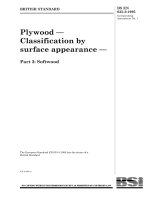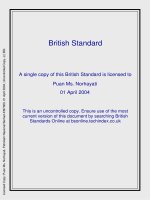Bsi bs en 61300 3 28 2012
Bạn đang xem bản rút gọn của tài liệu. Xem và tải ngay bản đầy đủ của tài liệu tại đây (1.1 MB, 18 trang )
BS EN 61300-3-28:2012
BSI Standards Publication
Fibre optic interconnecting
devices and passive
components — Basic test and
measurement procedures
Part 3-28: Examinations and
measurements – Transient loss
BRITISH STANDARD
BS EN 61300-3-28:2012
National foreword
This British Standard is the UK implementation of EN 61300-3-28:2012. It is
identical to IEC 61300-3-28:2012. It supersedes BS EN 61300-3-28:2002
which is withdrawn.
The UK participation in its preparation was entrusted by Technical Committee
GEL/86, Fibre optics, to Subcommittee GEL/86/2, Fibre optic interconnecting
devices and passive components.
A list of organizations represented on this committee can be obtained on
request to its secretary.
This publication does not purport to include all the necessary provisions of a
contract. Users are responsible for its correct application.
© The British Standards Institution 2012
Published by BSI Standards Limited 2012
ISBN 978 0 580 67457 0
ICS 33.180.20
Compliance with a British Standard cannot confer immunity from
legal obligations.
This British Standard was published under the authority of the Standards
Policy and Strategy Committee on 31 May 2012.
Amendments issued since publication
Date
Text affected
BS EN 61300-3-28:2012
EUROPEAN STANDARD
EN 61300-3-28
NORME EUROPÉENNE
April 2012
EUROPÄISCHE NORM
ICS 33.180.20
Supersedes EN 61300-3-28:2002
English version
Fibre optic interconnecting devices and passive components Basic test and measurement procedures Part 3-28: Examinations and measurements Transient loss
(IEC 61300-3-28:2012)
Dispositifs d'interconnexion et composants
passifs à fibres optiques Méthodes fondamentales d'essais et de
mesures Partie 3-28: Examens et mesures Perte transitoire
(CEI 61300-3-28:2012)
Lichtwellenleiter Verbindungselemente und passive
Bauteile Grundlegende Prüf- und Messverfahren Teil 3-28: Untersuchungen und
Messungen Transiente Dämpfung
(IEC 61300-3-28:2012)
This European Standard was approved by CENELEC on 2012-04-19. CENELEC members are bound to comply
with the CEN/CENELEC Internal Regulations which stipulate the conditions for giving this European Standard
the status of a national standard without any alteration.
Up-to-date lists and bibliographical references concerning such national standards may be obtained on
application to the CEN-CENELEC Management Centre or to any CENELEC member.
This European Standard exists in three official versions (English, French, German). A version in any other
language made by translation under the responsibility of a CENELEC member into its own language and notified
to the CEN-CENELEC Management Centre has the same status as the official versions.
CENELEC members are the national electrotechnical committees of Austria, Belgium, Bulgaria, Croatia, Cyprus,
the Czech Republic, Denmark, Estonia, Finland, France, Germany, Greece, Hungary, Iceland, Ireland, Italy,
Latvia, Lithuania, Luxembourg, Malta, the Netherlands, Norway, Poland, Portugal, Romania, Slovakia, Slovenia,
Spain, Sweden, Switzerland, Turkey and the United Kingdom.
CENELEC
European Committee for Electrotechnical Standardization
Comité Européen de Normalisation Electrotechnique
Europäisches Komitee für Elektrotechnische Normung
Management Centre: Avenue Marnix 17, B - 1000 Brussels
© 2012 CENELEC -
All rights of exploitation in any form and by any means reserved worldwide for CENELEC members.
Ref. No. EN 61300-3-28:2012 E
BS EN 61300-3-28:2012
EN 61300-3-28:2012
-2-
Foreword
The text of document 86B/3334/FDIS, future edition 2 of IEC 61300-3-28, prepared by SC 86B, "Fibre
optic interconnecting devices and passive components", of IEC TC 86, "Fibre optics" was submitted to the
IEC-CENELEC parallel vote and approved by CENELEC as EN 61300-3-28:2012.
The following dates are fixed:
•
•
latest date by which the document has
to be implemented at national level by
publication of an identical national
standard or by endorsement
latest date by which the national
standards conflicting with the
document have to be withdrawn
(dop)
2013-01-19
(dow)
2013-04-19
This document supersedes EN 61300-3-28:2002.
Changes from EN 61300-3-28:2002 are to update the test method and to reconsider the requirements.
Attention is drawn to the possibility that some of the elements of this document may be the subject of
patent rights. CENELEC [and/or CEN] shall not be held responsible for identifying any or all such patent
rights.
Endorsement notice
The text of the International Standard IEC 61300-3-28:2012 was approved by CENELEC as a European
Standard without any modification.
In the official version, for Bibliography, the following notes have to be added for the standards indicated:
IEC 60793-2
NOTE Harmonized as EN 60793-2.
IEC 61300-3-4
NOTE Harmonized as EN 61300-3-4.
-3-
BS EN 61300-3-28:2012
EN 61300-3-28:2012
Annex ZA
(normative)
Normative references to international publications
with their corresponding European publications
The following documents, in whole or in part, are normatively referenced in this document and are
indispensable for its application. For dated references, only the edition cited applies. For undated
references, the latest edition of the referenced document (including any amendments) applies.
NOTE When an international publication has been modified by common modifications, indicated by (mod), the relevant EN/HD
applies.
Publication
Year
Title
EN/HD
Year
IEC 60825-1
-
Safety of laser products Part 1: Equipment classification and
requirements
EN 60825-1
-
IEC 61300-1
2011
Fibre optic interconnecting devices and
passive components - Basic test and
measurement procedures Part 1: General and guidance
EN 61300-1
2011
IEC 61300-3-1
-
Fibre optic interconnecting devices and
passive components - Basic test and
measurement procedures Part 3-1: Examinations and measurements Visual examination
EN 61300-3-1
-
IEC 61300-3-35
-
EN 61300-3-35
Fibre optic interconnecting devices and
passive components - Basic test and
measurement procedures Part 3-35: Examinations and measurements Fibre optic cylindrical connector endface
visual and automated inspection
-
–2–
BS EN 61300-3-28:2012
61300-3-28 © IEC:2012
CONTENTS
1
Scope ............................................................................................................................... 5
2
Normative references ....................................................................................................... 5
3
Precautions ...................................................................................................................... 5
4
Apparatus ......................................................................................................................... 6
5
4.1 General description ................................................................................................. 6
4.2 Launch conditions and source (S) ........................................................................... 6
4.3 Optical detector (D) ................................................................................................. 7
4.4 Data acquisition system (DAS) ................................................................................ 8
4.5 Temporary joint (TJ) ................................................................................................ 8
4.6 Fibre ....................................................................................................................... 8
4.7 Mode filter (mf) ........................................................................................................ 8
Procedure ........................................................................................................................ 9
6
5.1 Pre-conditioning ...................................................................................................... 9
5.2 Visual inspection ..................................................................................................... 9
5.3 Transient loss measurements .................................................................................. 9
Details to be specified .................................................................................................... 11
Annex A (informative) Minimum characteristics for analogue-to-digital converter ................. 12
Bibliography .......................................................................................................................... 13
Figure 1 – Transient loss measurement set-up ........................................................................ 6
Figure 2 – Transient loss measurement ................................................................................ 10
Figure 3 – Example of a transient loss measurement with oscilloscope ................................. 10
Figure A.1 – Typical apparatus for measurement .................................................................. 12
Table 1 – Preferred source ..................................................................................................... 7
Table 2 – Preferred optical detector parameters ..................................................................... 7
BS EN 61300-3-28:2012
61300-3-28 © IEC:2012
–5–
FIBRE OPTIC INTERCONNECTING DEVICES
AND PASSIVE COMPONENTS –
BASIC TEST AND MEASUREMENT PROCEDURES –
Part 3-28: Examinations and measurements –
Transient loss
1
Scope
This part of IEC 61300 describes methods to measure fast variation of attenuation due to
mechanical stresses applied on optical fibres and passive optical components during their
lifetime.
Transient loss measurement shows the effect of fast mechanical disturbances on fibres.
These disturbances can be due to several types of action on the device under test (DUT),
such as: dropping, vibration, bumping or manipulation of the fibres. Therefore this
measurement will usually be performed on devices exposed to mechanical tests.
This method is not designed to measure very fast transient losses (with duration less than
1 ms) that could affect the performance of transmission systems. It is optimised to detect
transient losses caused by mechanical stresses due to the tests prescribed in the component
performance standards, whose duration is generally longer than several tens of milliseconds.
2
Normative references
The following documents, in whole or in part, are normatively referenced in this document and
are indispensable for its application. For dated references, only the edition cited applies. For
undated references, the latest edition of the referenced document (including any
amendments) applies.
IEC 61300-1:2011, Fibre optic interconnecting devices and passive components – Basic test
and measurement procedures – Part 1: General and guidance
IEC 61300-3-1, Fibre optic interconnecting devices and passive components – Basic test and
measurement procedures – Part 3-1: Examinations and measurements – Visual examination
IEC 61300-3-35, Fibre optic interconnecting devices and passive components – Basic test
and measurement procedures – Part 3-35: Examinations and measurements – Fibre optic
connector endface visual and automatic inspection
IEC 60825-1, Safety of laser products – Part 1: Equipment classification and requirements
3
Precautions
The power in the fibre shall not be at a level high enough to generate non-linear scattering
effects.
The position of the fibres between the measurement equipment and the DUT should be fixed
during the measurements to avoid changes in attenuation due to bending loss.
The safety recommendations in IEC 60825-1 shall be followed.
BS EN 61300-3-28:2012
61300-3-28 © IEC:2012
–6–
4
4.1
Apparatus
General description
The test equipment requires a fast optical detector with an analogue electrical output in order
to detect loss variations of duration in the range from the millisecond to several seconds. In
cases where transient losses less than 0,5 ms need to be measured the equipment must be
able to sample at twice the expected transient speed / frequency.
The measurement set-up is shown in Figure 1.
TJ
S
D
DUT
mf
mf
DAS
IEC 217/12
Key
S
Source
TJ
Temporary joint
DUT
Device Under Test
D
Optical detector
DAS
Data acquisition system
mf
Mode filter
Figure 1 – Transient loss measurement set-up
4.2
Launch conditions and source (S)
The launch condition shall be specified in accordance with Clause 9 of IEC 61300-1:2011.
The source unit consists of an optical emitter, the associated drive electronics and fibre pigtail
(if any). Preferred source conditions are given in Table 1. Preferably unpolarized light shall be
used. The optical source shall be continuous wave (CW) or shall have a high frequency
modulation in order to detect transient losses of 0,5 ms.
BS EN 61300-3-28:2012
61300-3-28 © IEC:2012
–7–
Table 1 – Preferred source
No.
Type
Centre wavelength
Nm
Source type
S1
Multi-mode
660 ± 30
LED
S2
Multi-mode
740 ± 30
LED
S3
Multi-mode
850 ± 30
Monochromator or LED
S4
Multi-mode
1 300 ± 30
Monochromator or LED
S5
Single-mode
1 310 ± 30
Laser diode, monochromator or LED
S6
Single-mode
1 550 ± 30
Laser diode, monochromator or LED
S7
Single-mode
1 625 ± 30
Laser diode, monochromator or LED
NOTE 1 It is recognized that CWDM and DWDM components may require the use of other source types such as
tuneable lasers. It is therefore recommended in these cases that the preferred source characteristics are
specified on the basis of the component to be measured.
NOTE 2
The modal launch condition for 660 nm is not defined yet.
The stability of the source at 23 ºC shall be ± 0,01 dB over the duration of the measurement.
The source output power shall be ≥ 20 dB above the minimum measured power level.
4.3
Optical detector (D)
The power-meter unit consists of an optical detector, the mechanism for connecting to it and
associated detection electronics. The connection to the optical detector will either be with an
adaptor that accepts a bare fibre or a connector plug of the appropriate design.
The measurement system shall be stable within specified limits over the period of time
required to make the measurements.
The precise characteristics of the detector shall be compatible with the measurement
requirements. The dynamic range of the optical detector shall be capable of measuring the
power level exiting from the DUT at the wavelength being measured. Moreover the optical
detector shall have a bandwidth at least of 2 kHz (in order to detect transient loss of 0,5 ms)
and an electrical output to the data acquisition system (DAS).
The preferred optical detector parameters are given in Table 2.
Table 2 – Preferred optical detector parameters
Number
Type
Non linearity
dB
Accuracy
D1
Multi-mode
≤ 0,25
(over – 5 dBm to – 60 dBm)
≤5%
D2
Single-mode
≤ 0,01
(Attenuation < 10 dB)
≤5%
≤ 0,05
(60 dB > Attenuation ≥ 10 dB)
In order to ensure that all light exiting the fibre is detected by the optical detector, the
sensitive area of the detector and the relative position between it and the fibre should be
compatible with the numerical aperture of the fibre.
–8–
BS EN 61300-3-28:2012
61300-3-28 © IEC:2012
The measurement stability of the complete set-up shall be better than 0,05 dB over the
measurement time and operational temperature range.
4.4
Data acquisition system (DAS)
A fast data acquisition system connected to the analogue electric output of the optical
detector, is used to record the transient loss variation acquired by the optical detector. The
DAS shall be able to store the data with the same acquisition frequency as the analogue
electric output of the optical detector in order to display and to detect its variation with time.
A simple DAS could be realised using an oscilloscope capable of memorising the level
received from the analogue electric output of the optical detector when it exceeds the trigger
threshold. This method requires the use of a sensitivity factor to convert the amplitude in Volts
into a power level, written in dB.
A more practical DAS is an analogue-to-digital converter connected to a personal computer.
The analogue-to-digital converter shall have a sufficient dynamic range (16 bits minimum,
24 bits is recommended to achieve a 0,001 dB resolution with most commercially available
optical detector) and shall have a sampling speed of at least 4 000 measurements per second
(see Annex A for more information). The settings of the analogue-to-digital converter shall be
made in such a way that the full output range of the analogue electrical output of the optical
detector can be covered.
In general, conversion to dB values is simultaneously made by the personal computer while
the measurements are taking place. To avoid the storage of a huge amount of data points, the
personal computer only needs to store one measurement per second when the trigger
threshold is not exceeded. Once the threshold level is exceeded, all data points during the
event as well as all data points of 1 second before and after the event shall be stored (at a
rate of at least 4 000 measurements/second). In case the signal does not return to its original
level again, a maximum acquisition time can be added to avoid the storage of an excessive
amount of data. After this pre-set time the personal computer will store only one measurement
per second again until a new event takes place. This method allows continuous transient loss
measurement without the need to interrupt the mechanical test when an event took place.
4.5
Temporary joint (TJ)
This is a method, device or mechanical fixture for temporarily aligning two fibre ends into a
stable, reproducible, low loss joint. It is used when direct connection of the DUT to the
measurement system is not achievable by a standard connector. It may, for example, be a
precision V-groove, vacuum chuck, a micromanipulator or a fusion or mechanical splice. The
temporary joint shall be stable to within ±10 % of the measurement accuracy required in dB
over the time taken to perform the measurements. A suitable refractive index matching
material may be used to improve the stability of the TJ.
4.6
Fibre
The fibre used to connect the source and optical detector to the DUT shall have the same
geometrical and optical characteristics as that used in the DUT.
4.7
Mode filter (mf)
The objective of a mode filter (mf) is to remove unwanted higher order modes and therefore
eliminate measurement inaccuracies. Specific details and requirements for mode filters are
contained in Clause 9 of IEC 61300-1:2011.
BS EN 61300-3-28:2012
61300-3-28 © IEC:2012
5
5.1
–9–
Procedure
Pre-conditioning
The optical interfaces of the DUT shall be clean and free from any debris likely to affect the
performance of the test and any resultant measurements. The manufacturer’s cleaning
procedure shall be followed.
The DUT shall be allowed to stabilize at room temperature for at least 1 h prior to testing.
5.2
Visual inspection
The optical interfaces shall be free from defects or damage which may affect the performance
of the test and any resultant measurements. It is recommended that a visual inspection of the
optical interfaces of the DUT is made in accordance with IEC 61300-3-1:2011 and
IEC 61300-3-35 prior to the start of the test.
5.3
Transient loss measurements
Depending on the type of DAS used, it will often be necessary to set the acquisition threshold
according to the minimum variation of attenuation that has to be detected. The threshold level
shall be fixed with care: if the value is too low it can result in frequent triggering by noise. A
trigger level set at 20 % of the variation in optical power level to be detected (in decibels) is
recommended.
When high polarised light sources such as laser diodes are used, the trigger value should not
become smaller than 0,2 dB. Lower trigger values could cause frequent triggering by noise or
PDL effects in the circuit. For low polarised light sources a minimum trigger level of 0,1 dB is
recommended.
The data will be acquired from the analogue electrical output of the optical detector in
continuous mode and the analysis can be performed at the end of the test.
The DUT shall be connected to the measurement set-up as in Figure 1. Before the start of the
test, the stable optical power level shall be measured and recorded.
The DUT shall be subjected to the test (mechanical, environmental or other) during which the
optical power level shall be monitored for transient losses.
After the test the stable optical power level shall be measured.
The variation of the power level before and after the test (= residual loss) and the maximum
variation recorded during the test (= transient loss) shall be recorded (see Figure 2).
BS EN 61300-3-28:2012
61300-3-28 © IEC:2012
– 10 –
0,5
Residual loss
0,0
Optical power (dBm)
-0,5
-1,0
-1,5
Transient Loss
-2,0
-2,5
-3,0
-3,5
0
0,5
1
Time (s)
1,5
2
IEC 218/12
Figure 2 – Transient loss measurement
Figure 3 gives as an example the result of a measurement made with the oscilloscope.
20 ms
20 µV
Noise
Upper trigger level
VTu = 1,325 mV
Level at initial condition V1 = 1,313 mV
Lower trigger level VTI = 1,301 mV
Transient level variation = 0,062 mV
equivalent to 0,42 dB (-20 log (V2/V1))
Level during the transient V2 = 1,251 mV
IEC 219/12
NOTE Graph obtained from an oscilloscope. In this example the trigger levels are set at ± 0,08 dB in respect to
the initial level (− 20 log (VT/V1)) because in this case the variations to be detected are greater than 0,2 dB. The
calculation of volts in dB is not always − 20 log (V1/V2). Most O/E converters have an electrical voltage output
which is linearly related to the optical power (expressed in watts). In this case, − 10 log (V1/V2) should be used. It
is important to check whether − 20 log (V1/V2) or −10 log (V1/V2) needs to be used for the conversion.
Figure 3 – Example of a transient loss measurement with oscilloscope
BS EN 61300-3-28:2012
61300-3-28 © IEC:2012
6
– 11 –
Details to be specified
The following details, as applicable, shall be specified in the relevant specification:
a) centre wavelength of the source;
b) optical detector characteristics;
c) maximum loss variation during the test;
d) maximum residual loss after the test;
e) optical fibre lengths;
f)
any deviations from the test procedure.
– 12 –
BS EN 61300-3-28:2012
61300-3-28 © IEC:2012
Annex A
(informative)
Minimum characteristics for analogue-to-digital converter
In general, most analogue electrical outputs from the optical detector have an output voltage
range between 0,2 V and 2 V. The typical apparatus for measurement is shown in Figure A.1.
Analogue electrical output
Light
source
Detector
0 V-2 V analogue
Optical power meter
Analogue-to-degital convertor
0 V-10 V
PC
Device under test
IEC 220/12
Figure A.1 – Typical apparatus for measurement
When the received optical power is changing, the optical detector electronics will make an
automatic ranging to optimize the amplifier characteristics for the level of received optical
power. Each time the range changes, the voltage of the analogue electrical output will jump
between the extreme voltage limits. To avoid switching between these ranges the "automatic
range" selection of the optical detector shall be switched off after a stable optical baseline is
set before the start of the measurements.
Assuming the analogue-to-digital converter has a 0 V to 10 V input range, each bit of a 16 bits
converter would represent 0,000 15 V (= 10 V divided by 65 000). A 0,01 dB change of the
lowest output voltage (around 0,2 V) represents a change in voltage of 0,000 23 V. Therefore
this resolution can be achieved with the 16 bits analogue-to-digital converter.
However, when a 0,001 dB is preferred as minimum detectable change in attenuation at 0,2 V,
a 24 bits analogue-to-digital converter is recommended to achieve this resolution.
In order to detect transient losses of 0,5 ms in duration the analogue-to-digital converter shall
have a minimum sampling speed of 4 000 measurements per second (assuming that the
electrical output of the optical detector has a bandwidth of at least 2 kHz).
BS EN 61300-3-28:2012
61300-3-28 © IEC:2012
– 13 –
Bibliography
IEC 60793-2, Optical fibres – Part 2: Product specifications – General
IEC 61300-3-4, Fibre optic interconnecting devices and passive components – Basic test and
measurement procedures – Part 3-4: Examinations and measurements – Attenuation
____________
This page deliberately left blank
This page deliberately left blank
NO COPYING WITHOUT BSI PERMISSION EXCEPT AS PERMITTED BY COPYRIGHT LAW
British Standards Institution (BSI)
BSI is the national body responsible for preparing British Standards and other
standards-related publications, information and services.
BSI is incorporated by Royal Charter. British Standards and other standardization
products are published by BSI Standards Limited.
About us
Revisions
We bring together business, industry, government, consumers, innovators
and others to shape their combined experience and expertise into standards
-based solutions.
Our British Standards and other publications are updated by amendment or revision.
The knowledge embodied in our standards has been carefully assembled in
a dependable format and refined through our open consultation process.
Organizations of all sizes and across all sectors choose standards to help
them achieve their goals.
Information on standards
We can provide you with the knowledge that your organization needs
to succeed. Find out more about British Standards by visiting our website at
bsigroup.com/standards or contacting our Customer Services team or
Knowledge Centre.
Buying standards
You can buy and download PDF versions of BSI publications, including British
and adopted European and international standards, through our website at
bsigroup.com/shop, where hard copies can also be purchased.
If you need international and foreign standards from other Standards Development
Organizations, hard copies can be ordered from our Customer Services team.
Subscriptions
Our range of subscription services are designed to make using standards
easier for you. For further information on our subscription products go to
bsigroup.com/subscriptions.
With British Standards Online (BSOL) you’ll have instant access to over 55,000
British and adopted European and international standards from your desktop.
It’s available 24/7 and is refreshed daily so you’ll always be up to date.
You can keep in touch with standards developments and receive substantial
discounts on the purchase price of standards, both in single copy and subscription
format, by becoming a BSI Subscribing Member.
PLUS is an updating service exclusive to BSI Subscribing Members. You will
automatically receive the latest hard copy of your standards when they’re
revised or replaced.
To find out more about becoming a BSI Subscribing Member and the benefits
of membership, please visit bsigroup.com/shop.
With a Multi-User Network Licence (MUNL) you are able to host standards
publications on your intranet. Licences can cover as few or as many users as you
wish. With updates supplied as soon as they’re available, you can be sure your
documentation is current. For further information, email
BSI Group Headquarters
389 Chiswick High Road London W4 4AL UK
We continually improve the quality of our products and services to benefit your
business. If you find an inaccuracy or ambiguity within a British Standard or other
BSI publication please inform the Knowledge Centre.
Copyright
All the data, software and documentation set out in all British Standards and
other BSI publications are the property of and copyrighted by BSI, or some person
or entity that owns copyright in the information used (such as the international
standardization bodies) and has formally licensed such information to BSI for
commercial publication and use. Except as permitted under the Copyright, Designs
and Patents Act 1988 no extract may be reproduced, stored in a retrieval system
or transmitted in any form or by any means – electronic, photocopying, recording
or otherwise – without prior written permission from BSI. Details and advice can
be obtained from the Copyright & Licensing Department.
Useful Contacts:
Customer Services
Tel: +44 845 086 9001
Email (orders):
Email (enquiries):
Subscriptions
Tel: +44 845 086 9001
Email:
Knowledge Centre
Tel: +44 20 8996 7004
Email:
Copyright & Licensing
Tel: +44 20 8996 7070
Email:
